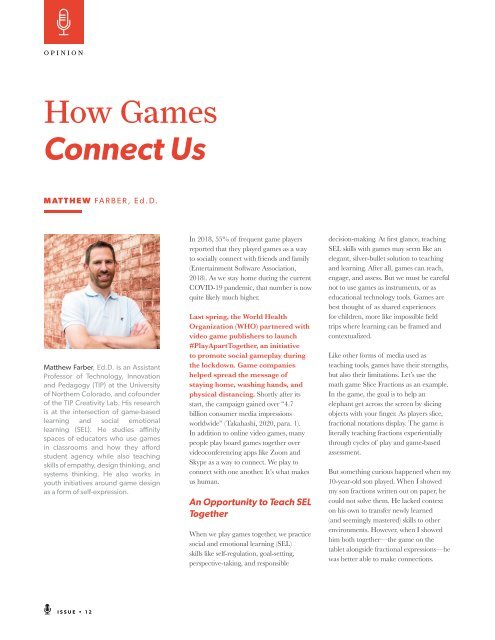The Blue DOT - 12: Reimagining Learning Spaces for Uncertain Times
You also want an ePaper? Increase the reach of your titles
YUMPU automatically turns print PDFs into web optimized ePapers that Google loves.
OPINION<br />
How Games<br />
OPINION<br />
Connect Us<br />
MATTHEW FARBER, Ed.D.<br />
Matthew Farber, Ed.D. is an Assistant<br />
Professor of Technology, Innovation<br />
and Pedagogy (TIP) at the University<br />
of Northern Colorado, and cofounder<br />
of the TIP Creativity Lab. His research<br />
is at the intersection of game-based<br />
learning and social emotional<br />
learning (SEL). He studies affinity<br />
spaces of educators who use games<br />
in classrooms and how they af<strong>for</strong>d<br />
student agency while also teaching<br />
skills of empathy, design thinking, and<br />
systems thinking. He also works in<br />
youth initiatives around game design<br />
as a <strong>for</strong>m of self-expression.<br />
In 2018, 55% of frequent game players<br />
reported that they played games as a way<br />
to socially connect with friends and family<br />
(Entertainment Software Association,<br />
2018). As we stay home during the current<br />
COVID-19 pandemic, that number is now<br />
quite likely much higher.<br />
Last spring, the World Health<br />
Organization (WHO) partnered with<br />
video game publishers to launch<br />
#PlayApartTogether, an initiative<br />
to promote social gameplay during<br />
the lockdown. Game companies<br />
helped spread the message of<br />
staying home, washing hands, and<br />
physical distancing. Shortly after its<br />
start, the campaign gained over “4.7<br />
billion consumer media impressions<br />
worldwide” (Takahashi, 2020, para. 1).<br />
In addition to online video games, many<br />
people play board games together over<br />
videoconferencing apps like Zoom and<br />
Skype as a way to connect. We play to<br />
connect with one another. It’s what makes<br />
us human.<br />
An Opportunity to Teach SEL<br />
Together<br />
When we play games together, we practice<br />
social and emotional learning (SEL)<br />
skills like self-regulation, goal-setting,<br />
perspective-taking, and responsible<br />
<br />
SEL skills with games may seem like an<br />
elegant, silver-bullet solution to teaching<br />
and learning. After all, games can teach,<br />
engage, and assess. But we must be careful<br />
not to use games as instruments, or as<br />
educational technology tools. Games are<br />
best thought of as shared experiences<br />
<br />
trips where learning can be framed and<br />
contextualized.<br />
Like other <strong>for</strong>ms of media used as<br />
teaching tools, games have their strengths,<br />
but also their limitations. Let’s use the<br />
math game Slice Fractions as an example.<br />
In the game, the goal is to help an<br />
elephant get across the screen by slicing<br />
<br />
fractional notations display. <strong>The</strong> game is<br />
literally teaching fractions experientially<br />
through cycles of play and game-based<br />
assessment.<br />
But something curious happened when my<br />
10-year-old son played. When I showed<br />
my son fractions written out on paper, he<br />
could not solve them. He lacked context<br />
on his own to transfer newly learned<br />
(and seemingly mastered) skills to other<br />
environments. However, when I showed<br />
<br />
<br />
was better able to make connections.<br />
Like books, film, and other<br />
media we use in learning<br />
contexts, games cannot<br />
stand on their own as<br />
teaching tools without<br />
an educator, parent, or<br />
caregiver to mediate<br />
transfer of learning.<br />
But what makes games<br />
unique <strong>for</strong> learning is that<br />
educators can play along<br />
with students, teaching<br />
them as they go!<br />
<br />
we use in learning contexts, games<br />
cannot stand on their own as<br />
teaching tools without an educator,<br />
parent, or caregiver to mediate<br />
transfer of learning. But what<br />
makes games unique <strong>for</strong> learning is<br />
that educators can play along with<br />
students, teaching them as they go!<br />
SEL Games to<br />
#PlayApartTogether<br />
After playing basketball or cricket, players<br />
(and onlookers) talk about the experience.<br />
Many games lead to a discussion<br />
among players, which is known as<br />
the metagame—the conversations<br />
around and outside of the game<br />
itself. This is often where teachable<br />
moments reside. This is one of the<br />
reasons we play to connect to one<br />
another.<br />
Next, I share two games I use that promote<br />
metagame conversation around SEL skills,<br />
in particular, ethical decision-making with<br />
perspective-taking. Using games, these two<br />
skills can be taught in tandem, as players<br />
ISSUE • <strong>12</strong><br />
2 3


















